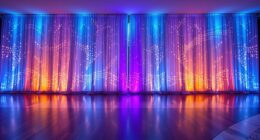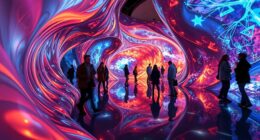Immersive dance and performance art installations transform traditional stages into multisensory environments that actively involve you. They blend innovative technologies like VR, AR, and motion capture with dynamic stage and costume design to create engaging, participatory experiences. Audience interaction is key, breaking down barriers between performer and viewer. As artists push boundaries with spatial, technological, and cultural innovations, you’ll discover how these experiences continue evolving—keeping you curious about what’s next in immersive performance art.
Key Takeaways
- Immersive dance and performance art installations create multisensory environments that actively engage audiences through movement, technology, and spatial design.
- They often incorporate audience participation, breaking traditional performer-audience boundaries to foster personal and emotional connections.
- Cutting-edge technologies like VR, AR, motion capture, and haptic feedback enhance sensory experiences and real-time interaction.
- Artists draw inspiration from experimental theater, installation art, and natural elements to craft site-specific, transformative performances.
- Challenges include high costs, technological barriers, accessibility issues, and the need for innovative, inclusive design strategies.
The Evolution of Immersive Performance Art
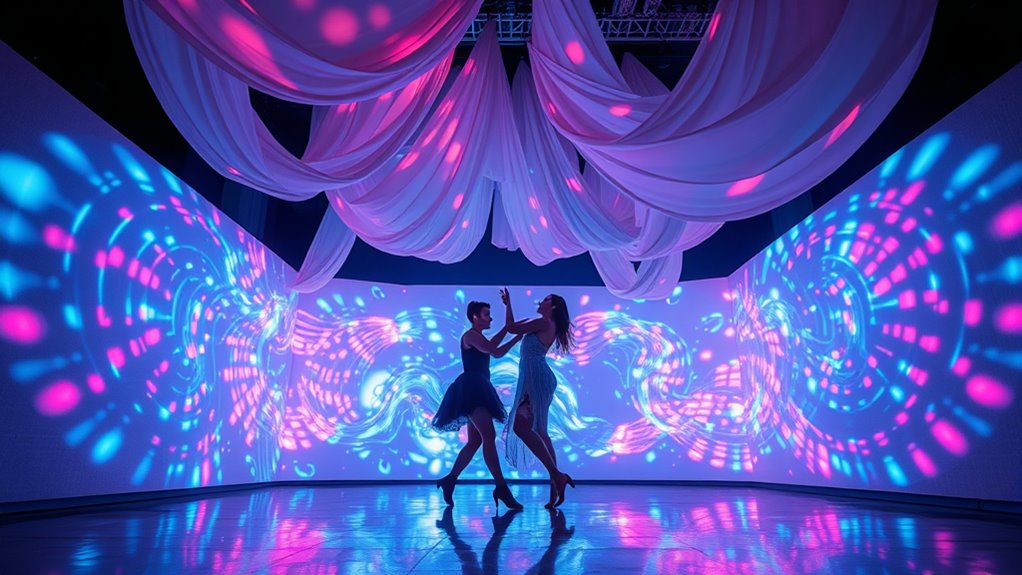
Immersive performance art has evolved considerably over the past few decades, transforming from traditional stage productions into dynamic, multisensory experiences. Understanding its historical context reveals how artists sought to break boundaries and engage audiences more deeply. Early influences stem from experimental theater and avant-garde movements of the 20th century, which emphasized audience participation and breaking the fourth wall. Artistic influences include happenings, performance art, and installation art, all pushing the limits of conventional performance. These movements emphasized spontaneity, interactivity, and sensory engagement, laying the groundwork for contemporary immersive experiences. Over time, technology and innovative spatial design further expanded possibilities, allowing artists to craft environments that fully envelop viewers. This evolution reflects a persistent drive to make performance more intimate, participatory, and emotionally resonant. Additionally, the incorporation of seasonal variations and natural elements has enriched the immersive experience, creating environments that resonate more deeply with audiences.
Key Elements of Immersive Dance Experiences

To create a truly immersive dance experience, artists focus on several key elements that work together to engage your senses and emotions fully. Stage design plays a vital role, transforming the performance space into a dynamic environment that surrounds you and enhances the narrative. It can include lighting, spatial arrangement, and interactive elements that make you feel part of the action. Costume design also contributes notably by reflecting the themes and characters, helping you connect with the performers on a deeper level. Well-crafted costumes blend seamlessly with the environment, amplifying the emotional impact. Additionally, self-watering plant pots can serve as innovative set pieces or interactive elements, adding a layer of organic connection and visual interest. Together, these elements create a cohesive atmosphere that pulls you into the performance, making the experience memorable and visceral. Attention to stage and costume design guarantees every detail heightens your sensory engagement.
Technologies Transforming Live Art Spaces
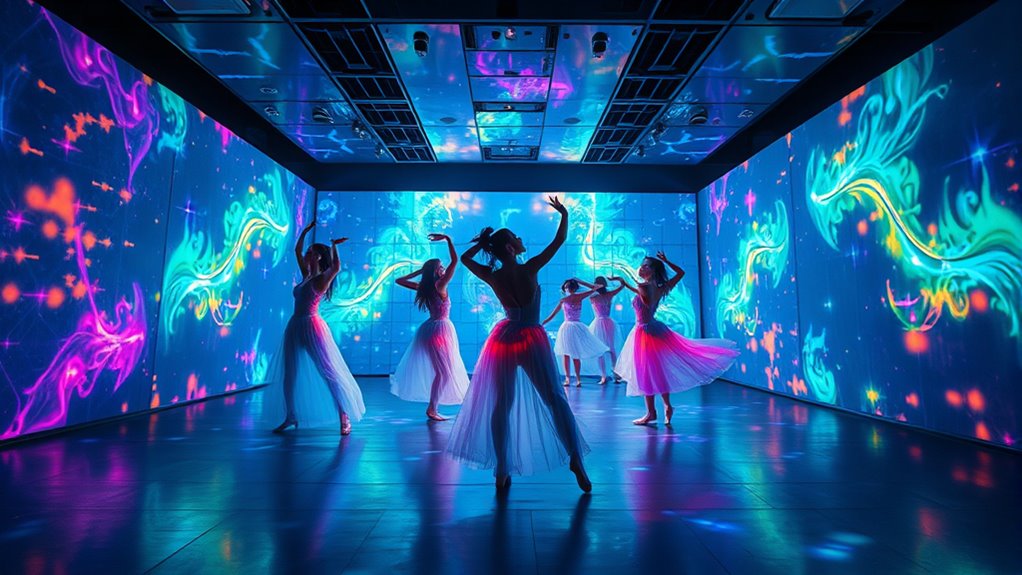
You can now see how Virtual and Augmented Reality reshape live performances, creating immersive worlds for audiences to explore. Motion Capture Technologies track performers’ movements precisely, blending human expression with digital enhancements. Interactive Digital Environments respond in real-time, transforming static spaces into dynamic, engaging art experiences. Additionally, essential oils are being incorporated into performances to evoke sensory responses and deepen audience engagement.
Virtual and Augmented Reality
Virtual and augmented reality technologies are revolutionizing live art spaces by creating new dimensions of interaction and immersion. With VR headsets and AR overlays, you can experience performances as if you’re truly inside them, engaging multiple senses. Haptic feedback devices allow you to feel textures, vibrations, and movements, enhancing the sense of presence. Scent integration adds another layer, filling the space with aromas that match the environment or narrative, deepening emotional responses. These tools break physical barriers, letting you explore environments and narratives beyond traditional stagecraft. Home-based experiences are also expanding, allowing viewers to enjoy immersive art from their own spaces. As a participant, you’re no longer just observing; you’re part of the artwork, shaping your experience in real-time. VR and AR turn live performances into multisensory journeys, transforming how you connect with dance and performance art.
Motion Capture Technologies
Motion capture technologies are rapidly transforming live art spaces by enabling performers’ movements to be recorded and translated in real time. Using advanced motion tracking and gesture recognition, artists can create dynamic visual effects that respond instantly to performers’ actions. This technology allows for seamless integration of human movement with digital environments, enhancing audience engagement. You can explore how performers’ gestures are captured and converted into digital signals, enabling precise control over visual and audio elements. The immediacy of this process opens new creative possibilities for immersive performances. Sound vibrations are also utilized in some interactive installations to synchronize with movement, further enriching the sensory experience.
Interactive Digital Environments
Advancements in motion capture have paved the way for immersive digital environments that actively respond to performers’ movements. You can now experience sensor integration and spatial mapping, which create dynamic, interactive spaces. These technologies track your motions and adapt visuals or sounds in real time, making performances more engaging. For example, sensor integration allows your gestures to influence digital projections, while spatial mapping accurately aligns virtual elements with physical surroundings. This setup transforms any live space into a responsive environment, heightening immersion. Here’s a quick look at key features:
| Feature | Benefit |
|---|---|
| Sensor Integration | Precise tracking of performer movements |
| Spatial Mapping | Virtual elements align seamlessly with physical space |
Furthermore, incorporating Honda Tuning concepts like ECU remapping and sensor-based modifications can inspire innovative ways to calibrate and optimize digital environments for live performances.
Notable Artists Leading the Immersive Movement
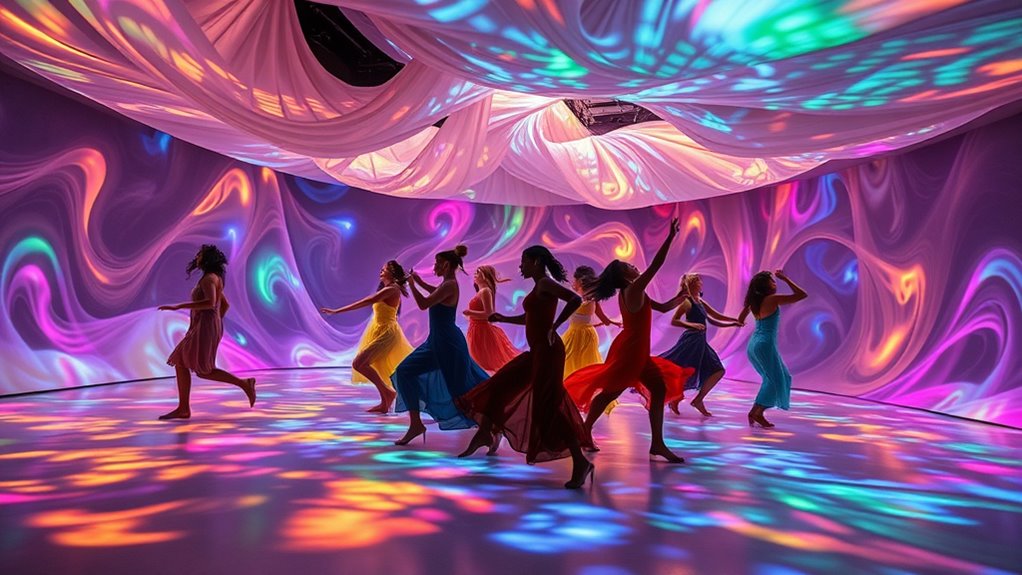
You’ll find that pioneering artists shape the immersive movement with bold visions and groundbreaking techniques. Their innovative approaches redefine how audiences experience performance art. Ultimately, their work leaves a lasting cultural impact that transforms the art world. Exploring organic and natural juices can inspire artists to incorporate natural elements into their immersive installations, creating multisensory experiences that resonate deeply with audiences.
Pioneering Artists’ Visions
Leading the charge in immersive dance and performance art are visionary artists who push boundaries and redefine audience engagement. These pioneers draw on a rich historical context, blending disciplines and challenging conventions. Their artistic collaborations often bring together dancers, technologists, and designers, creating multifaceted experiences. You’ll find that their visions emphasize emotional immersion and spatial innovation, transforming traditional stages into interactive environments. These artists believe that breaking down barriers between performer and viewer enhances storytelling. Their work often involves site-specific installations that evolve with audience movement. Their pioneering efforts inspire new generations to think beyond conventional performance, making every piece a unique fusion of art forms. By continuously redefining what performance can be, these trailblazers shape the future of immersive art. Incorporating airless paint sprayers into their stage setups demonstrates their commitment to innovative environments and seamless visual effects.
Innovative Techniques Employed
Innovative techniques are at the heart of what sets immersive dance and performance art apart, driven by artists who continually experiment with new tools and methods. You’ll notice how sound design becomes a dynamic part of the experience, enveloping you and enhancing emotional resonance. Spatial choreography transforms the stage, blurring the lines between performer and audience as movements flow seamlessly through the space. Artists often employ cutting-edge technology, such as 3D sound systems and real-time projections, to create a multi-sensory environment. These techniques foster deeper engagement, making you feel like an active participant rather than a passive observer. Additionally, understanding the emotional support aspects of immersive experiences can enhance your emotional connection to the art, providing comfort and insight. By pushing boundaries with innovative approaches, these artists redefine what performance art can be, inviting you into immersive worlds that challenge traditional notions of theater and dance.
Cultural Impact Significance
Notable artists are shaping the immersive dance and performance art movement by challenging traditional boundaries and expanding cultural conversations. Their work often uses cultural symbolism to reflect societal narratives, encouraging audiences to re-examine their perspectives. These artists push the limits of expression, making immersive experiences powerful tools for social commentary. They influence how communities interpret identity, history, and collective memory, fostering dialogue around pressing issues. By integrating cultural symbolism, their installations resonate deeply, transforming perceptions and sparking cultural shifts. Their innovative approaches help redefine the role of performance art within society. Additionally, many of these artists explore cosmic connections between astrology and symbolism, adding a layered depth to their immersive narratives.
Interaction and Audience Participation

Interaction and audience participation are essential elements that transform immersive dance and performance art from passive observations into active experiences. When you engage with the performance, you become part of the story, influencing its flow and meaning. This heightened audience engagement results from carefully crafted participatory design, which encourages viewers to move, respond, or make decisions within the installation. Your participation blurs the line between performer and spectator, creating a dynamic, personalized experience. By actively contributing, you help shape the environment and narrative, making the performance more impactful. This approach fosters deeper emotional connections and a sense of ownership, transforming a simple viewing into an unforgettable, interactive journey that leaves a lasting impression. Incorporating audience participation can also enhance the overall impact and effectiveness of the installation.
Case Studies of Pioneering Installations
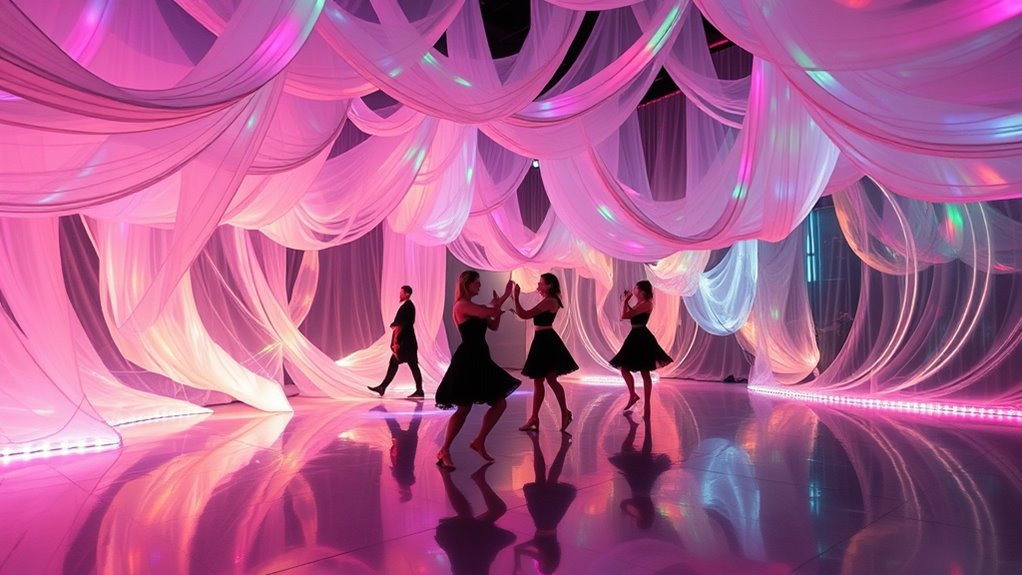
One of the most compelling ways to understand the impact of immersive dance and performance art is by examining pioneering installations that have pushed creative boundaries. These projects transformed audience perception by blurring the lines between performer and viewer, creating intimate and interactive experiences. Spatial design plays a vital role, shaping how audiences move through and engage with the environment. For example:
- Rain Room by Random International, where controlled water installations challenge perceptions of space and interaction
- Sleep No More by Punchdrunk, which uses intricate spatial design to immerse audiences in a narrative maze
- The Infinity Room by Yayoi Kusama, creating a sense of endless space through visual illusions
- Refik Anadol’s Data Sculptures, blending digital environments with physical space for dynamic audience engagement
- Thoughtful spatial planning enhances the emotional and sensory impact of immersive art, making the experience more memorable for viewers.
Challenges and Limitations in Immersive Art
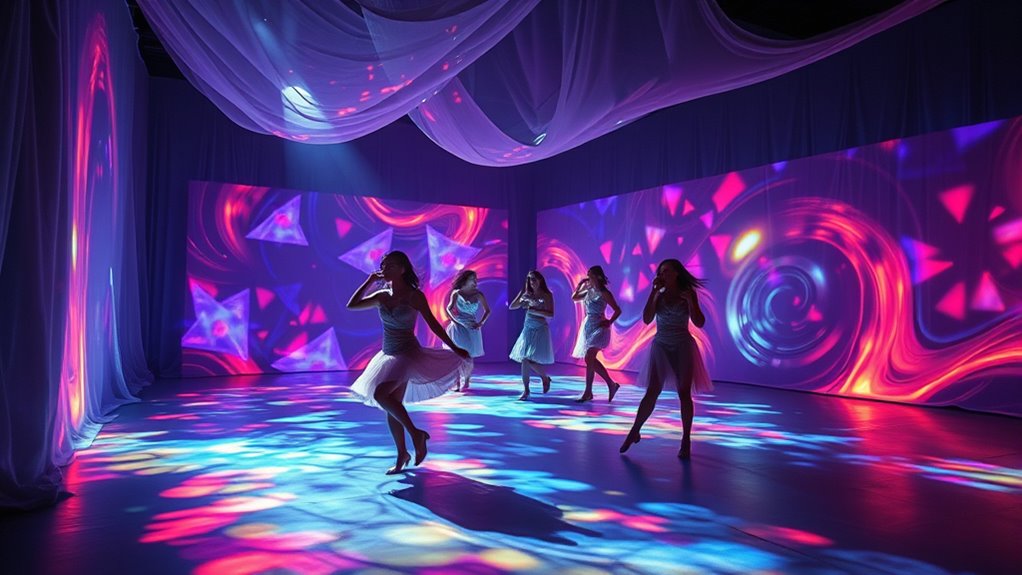
While immersive art offers groundbreaking experiences, it also faces significant challenges that can limit its effectiveness and accessibility. Technological barriers can hinder implementation, as not all venues have the necessary infrastructure or equipment to support complex installations. You might find that high-quality immersive experiences require advanced projection systems, sensors, and sound design, which can be difficult to access or operate. Budget constraints further complicate matters, restricting artists’ ability to create ambitious projects or maintain installations over time. These financial limitations can prevent widespread adoption or limit the scale of immersive works. Additionally, the costs of evolving technology mean that ongoing updates and maintenance are often necessary, adding to the financial burden. As a result, some audiences may miss out on these transformative artistic experiences.
The Future of Multi-Sensory Performance Experiences
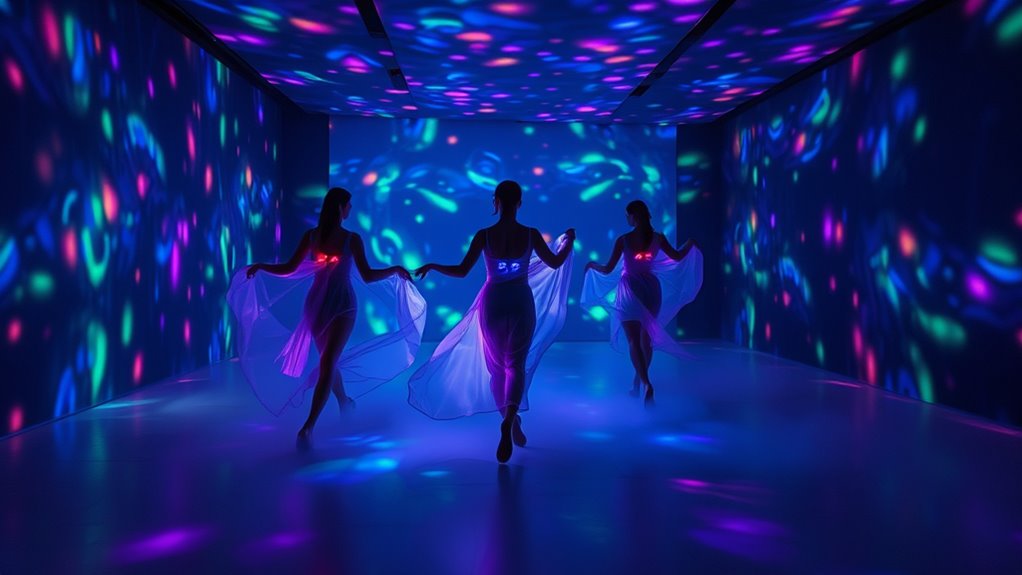
Advancements in technology are paving the way for increasingly immersive and multi-sensory performance experiences that can deeply engage audiences. Future innovations will harness soundscapes and sensory stimulation to create richer, more personalized environments. Imagine performances where you’re surrounded by dynamic visual effects, tactile feedback, and immersive audio that respond in real-time. These experiences will blur the lines between performer and spectator, making you an active participant. Technologies like spatial audio, haptic feedback, and virtual reality will evolve to craft seamless, multisensory worlds. You’ll see performances that adapt to your responses, heightening emotional impact. Family dynamics insights have influenced the development of interactive performance narratives, fostering deeper connections between performers and audiences. – Real-time sensory customization tailored to your reactions – Integration of augmented reality for layered experiences – Enhanced soundscapes that react to movement – Use of multisensory cues to evoke stronger emotions
Cultural Impact and Audience Engagement

Immersive dance and performance art installations are revolutionizing how audiences connect with art, fostering deeper cultural conversations and shared experiences. You’re no longer just observing; you’re actively participating, which shifts your perception of the performance. These installations invite you to engage with cultural storytelling on a personal level, making the experience more meaningful. As you move through the space, your interactions influence how you interpret the narrative and its cultural significance. This immersive approach breaks down traditional barriers, encouraging dialogue and reflection among viewers. The heightened audience perception creates a sense of collective ownership, strengthening cultural understanding. Additionally, the diverse genres of content, including action, romance, and fantasy, showcased in various installations, enrich your engagement and understanding of different cultural narratives. Ultimately, these installations deepen your connection to diverse stories, making the art form a integral tool for cultural dialogue and community building.
Creating Accessible and Inclusive Immersive Environments
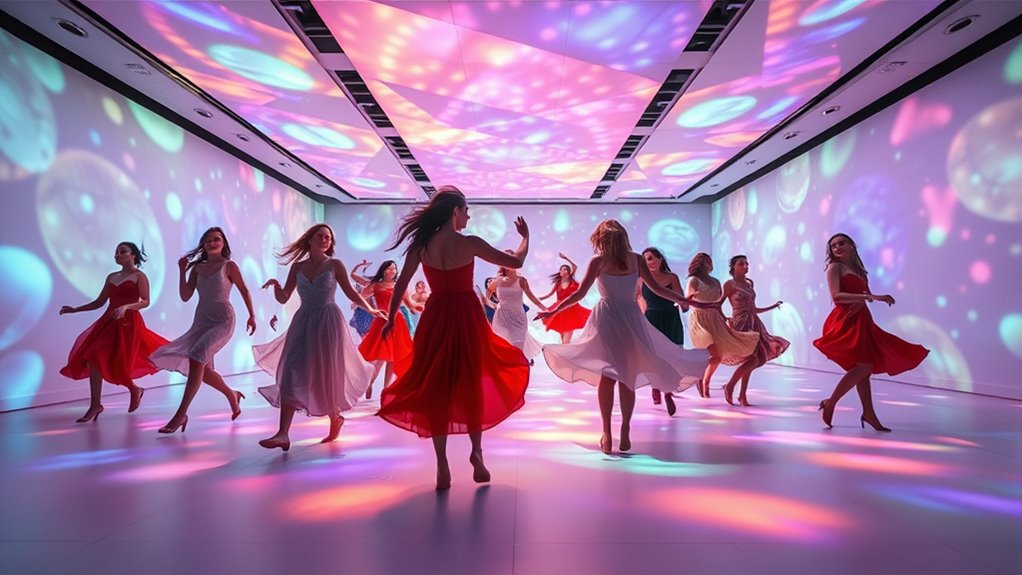
Creating accessible and inclusive immersive environments requires intentional design choices that prioritize the diverse needs of all participants. To guarantee genuine audience immersion, consider incorporating sensory deprivation options for those who need relief from overwhelming stimuli. This helps create a comfortable space where everyone can engage meaningfully. Use clear signage and assistive technologies to support visitors with disabilities. Foster an environment where sensory input can be customized, allowing participants to tailor their experience. Incorporate features like adjustable lighting, sound levels, and tactile guides. By doing so, you invite a broader audience to participate fully. Necessary Cookies can be employed to ensure the functionality of assistive features and enhance overall accessibility.
Frequently Asked Questions
How Do Artists Measure Success in Immersive Dance Installations?
You measure success in immersive dance installations through audience engagement and artistic innovation. If viewers actively participate, interact, and feel emotionally connected, you see that as a positive sign. Additionally, if your work pushes boundaries, introduces new concepts, and sparks conversations, it’s a mark of artistic innovation. Ultimately, success comes when your installation leaves a lasting impression, inspiring both your audience and your creative growth.
What Funding Options Are Available for New Immersive Performance Projects?
Imagine you’re a time traveler, seeking funding for your immersive project. You can explore grant opportunities from arts councils, foundations, and cultural institutions that support innovative performance art. Additionally, crowdfunding strategies on platforms like Kickstarter or Indiegogo let you rally community support and raise funds directly from your audience. Combining these options boosts your chances of securing the resources needed to bring your immersive dance experience to life.
How Do Immersive Experiences Accommodate Audiences With Disabilities?
You can make immersive experiences accessible by incorporating accessible design and sensory accommodations. This involves providing features like ramps, tactile guides, and audio descriptions to support diverse needs. You might also offer quiet zones and adjustable sensory stimuli to guarantee comfort. By actively considering these elements during planning, you create an inclusive environment that welcomes all audiences, allowing everyone to fully engage and enjoy the performance.
What Safety Protocols Are Essential During Interactive Performance Art Events?
Imagine safety as the invisible shield guarding your experience. You must implement clear emergency response plans, ensuring staff are trained and accessible. Audience monitoring keeps an eye on everyone’s well-being, catching issues before they escalate. You should also have accessible exits, first aid stations, and communication systems in place. These protocols create a secure environment, letting you fully immerse yourself while knowing safety measures are woven into the event’s fabric.
How Do Cultural Differences Influence Immersive Dance Installation Design?
You should consider how cultural differences influence your immersive dance installation design by incorporating cultural symbolism and traditional motifs that resonate with diverse audiences. These elements help create authentic experiences and foster connection. Be mindful of cultural sensitivities and avoid stereotypes, ensuring your design respects and celebrates each culture’s unique expressions. This approach enriches your work, making it more inclusive and meaningful for participants from varied backgrounds.
Conclusion
As you explore immersive dance and performance art, you’ll find that over 60% of audiences report feeling more connected and engaged in these environments. This powerful connection transforms traditional experiences, making art more personal and impactful. As technology advances, expect even richer multi-sensory encounters that break barriers and invite everyone to participate. Embrace these evolving performances, and you’ll discover a dynamic world where your presence truly shapes the art itself.







